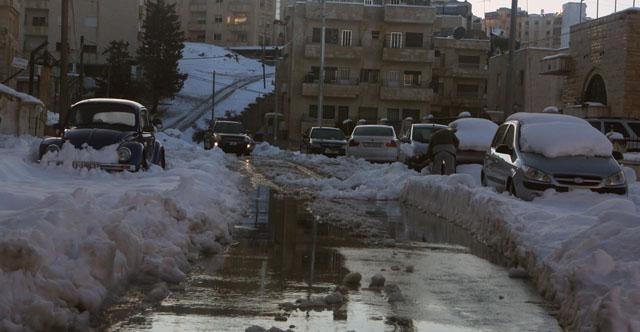You are here
‘Sprinkling salt on roads could damage crops, cars’
By Hana Namrouqa - Jan 28,2016 - Last updated at Jan 28,2016

A Greater Amman Municipality truck sprinkles salt on a street in the capital recently (Photo courtesy of GAM)
AMMAN — With the Greater Amman Municipality (GAM) using 17 salt-spreading trucks to melt ice on roads, water officials and car mechanics warned on Thursday that sodium chloride pollutes water and damages vehicles.
Sub-zero temperatures during this week in the capital prompted the municipality to start spreading salt as of Tuesday to melt ice on main roads, bridges, tunnel entrances and steep roads.
But the move was not welcomed by the Ministry of Water and Irrigation, which said sprinkling salt on the streets will increase the salinity of rainwater that reaches the dams.
“The rainwater, which eventually finds its way to King Talal Dam, will become saline. The wet season is usually anticipated because the rainwater improves the quality of the dam’s water and reduces salinity levels,” the ministry’s assistant secretary general, Adnan Zu’bi, told The Jordan Times.
Zu’bi underscored that increasing salinity levels at the 75-million-cubic-metre King Talal Dam will damage crops in the Jordan Valley, as certain crops are irrigated from the dam.
“Saline rainwater will also directly impact the soil and the crops and affect the agricultural sector,” Zu’bi said.
Meanwhile, Ahmad Ghazawi, owner of an auto repair shop in Naour, said that spreading salt on the streets during winter damages vehicles in the long run.
“Salt causes corrosion and shortens the life of cars. It embeds itself in the undercarriage, causing it to rust over time. In addition, it can eat away the paint,” Ghazawi told The Jordan Times.
He advised motorists to head to car wash stations and clean salt and dirt off their cars to prevent corrosion.
“Also, spraying car oil on the undercarriage is a good idea to create an isolating layer,” Ghazawi said.
The municipality announced at the start of winter that it has increased its fleet of salt spreaders from two to 17 trucks, noting that most of the salt sprinkling on the capital’s roads was previously done manually.
The salt is mixed with sand to ensure it sticks to the snow or ice and to make the de-icing process faster, according to GAM.
Related Articles
AMMAN — Seventeen salt spreader trucks will be put into service this winter to sprinkle salt to melt ice and snow on roads across the
The Greater Amman Municipality (GAM) is handling the aftermath of the blizzard and doing maintenance work on the capital’s streets, a GAM official said on Tuesday.
AMMAN — The Greater Amman Municipality (GAM) on Thursday unveiled its plans to ensure public safety ahead of the polar front, expected to br
















